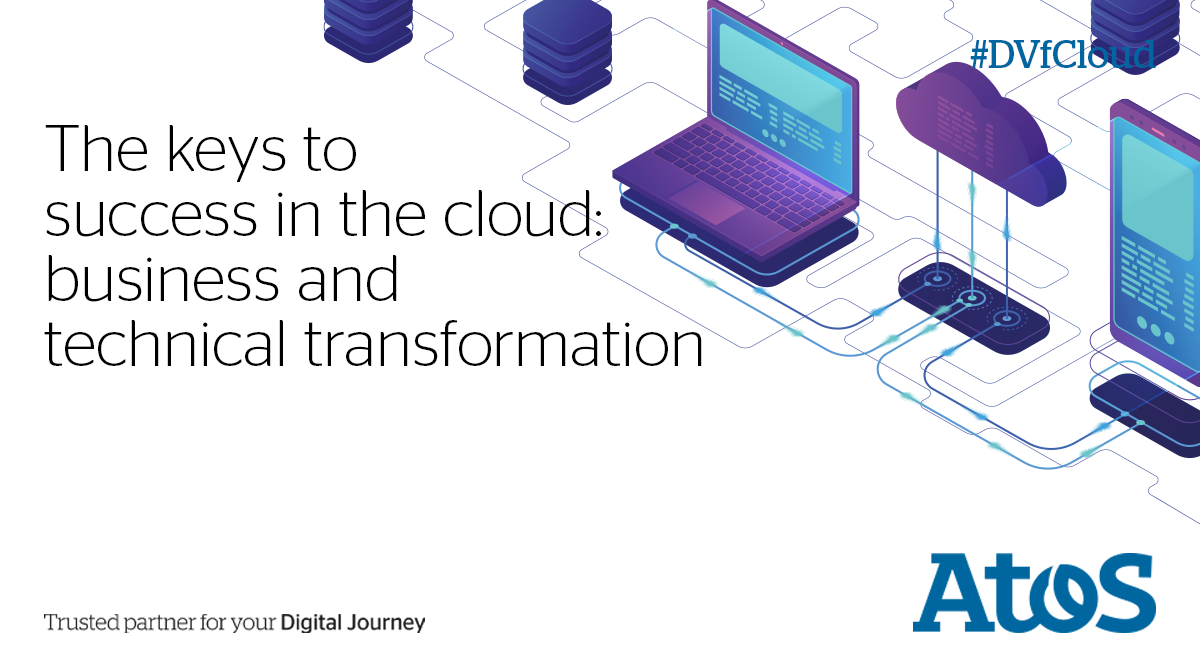The keys to success in the cloud: business and technical transformation
by Dirk Frederickx, Account Delivery Executive, Atos Belgium
Brussels, June 11, 2019
Cloudification – the move to the cloud – can never be an isolated project; very often, it becomes part of a larger business and IT transformation project. Even if this is not clear at the beginning of the journey, cloud transformation often develops into a larger endeavour in order to fully realise the benefits of the cloud – like cost reduction, faster time to market and agility.
From our experience and from what we have seen in the market, digital transformation and business transformation go hand in hand. Transformation journeys are almost always initiated in response to a business need: whether the requirement is to process data more efficiently and more securely, to extend the business into the mobile and social space, or to adapt the capability of an organisation to respond to business growth and changing customer needs.
 Moving to the cloud is no exception to this rule. Organisations move to the cloud to reduce costs or to quickly build and modify applications that would otherwise have taken several months to complete. Nowadays, cloud computing has become an important weapon in any business transformation project. The level of maturity and standardisation that cloud technologies have reached today has become an important driver for the increasing cloud adoption that we witness every day.
Moving to the cloud is no exception to this rule. Organisations move to the cloud to reduce costs or to quickly build and modify applications that would otherwise have taken several months to complete. Nowadays, cloud computing has become an important weapon in any business transformation project. The level of maturity and standardisation that cloud technologies have reached today has become an important driver for the increasing cloud adoption that we witness every day.
This does not mean, however, that we are well on our way to a fully integrated and optimised environment. Most customers are still facing a huge legacy of data and applications running on old platforms. It would therefore be senseless to move all of it towards the cloud. Firstly, not all applications or data are cloud-ready. For some applications, it makes more sense to start from scratch than to try and migrate them to the cloud. Secondly, simply moving the current infrastructure to the cloud would mean transferring your old problems to the cloud as well.
Careful preparation, thoughtful integration, reliable operation
Almost every cloud migration project will therefore be either the trigger for, or the consequence of, a larger transformation project. If it isn’t, the benefits of cloudification will always remain suboptimal. Cloudification should be part of a general business process improvement exercise, and of a technology overhaul making the apps and data more flexible, accessible and more easily integrated. A successful cloudification strategy will always include careful preparation, thoughtful integration of cloud and non-cloud assets, and a revised set of Service Level Agreements driving Business Level Agreements to ensure reliable operations.
Part of the preparation will consist of redeveloping applications to leverage open standards and APIs on the one hand and to make them more modular and reusable on the other. It will also involve centralising, clustering and modifying databases, in order to make data more accessible and to combine data from several sources more easily. And it will require a more industrialised approach to developing applications, which will contribute to speeding up development cycles. Faster time-to-market is one of the main drivers for cloud computing.
Thoughtful integration will consist of two phases. In a first phase, all apps and data must be scrutinised to decide what would be the best possible business decision for each app, for example:
- standardise to an industry standard SaaS
- develop a custom cloud-native application
- modernise the app and moving it to a PaaS
- wrap the existing application and move it to IaaS
- leave the application as-is
- phase out applications that can be made obsolete or redundant
In a next phase, it will be necessary to ensure that everything works together seamlessly, not only technically, but also enabling smoother business processes. Business users need to enjoy an easier and more intuitive user experience. This means, for instance, accessing cloud and non-cloud assets from the same user interface without requiring several user-IDs and passwords.
When implementing the cloud transformation, two main principles need to be upheld: ‘think big’ and ‘use small steps’. When you combine the big picture with small subsequent steps, you usually get the best results at the highest possible speed. Cloud technologies are a key enabler for agile development processes. This provides you with a headstart on this important transformation journey.